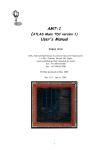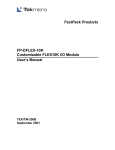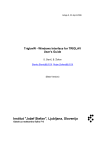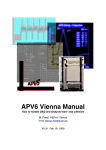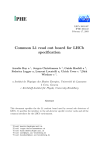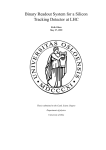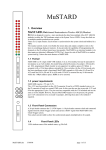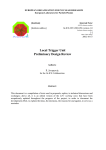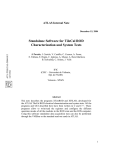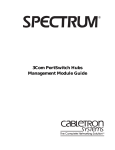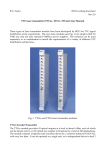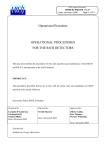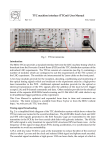Download User Manual
Transcript
Vertex Detector Electronics: ODE Pre-Prototype User Manual Issue: Revision: 2 3 Reference: Created: Last modified: IPHE 2000-008, LHCb 2001-057 VELO 28 February 2000 1 March 2002 Prepared By: Yuri Ermoline Vertex Detector Electronics: ODE Pre-Prototype User Manual Abstract Ref: IPHE 2000-008, LHCb 2001-057 VELO Issue: 2 Revision: 3 Date: 1 March 2002 Abstract This document is a user manual for the ODE pre-prototype module (ODEPP, also frequently referred as Read-out Board number 2, RB2). The module is under development and new features are implemented in every new version. Document Status Sheet Table 1 Document Status Sheet 1. Document Title: Vertex Detector Electronics: ODE Pre-Prototype 2. Document Reference Number: IPHE 2000-008, LHCb 2001-057 VELO 3. Issue page ii 4. Revision 5. Date 6. Implemented features 1 0 2 Mar 2000 VME slave interface A24/D32, CSR0, CSR1, FIFO, VME trigger, PDU control, MODE=“00” implemented (continuous data capture, starting on trigger) 1 1 22 Mar 2000 VME reset, TTC trigger, added 24-bit trigger counter 1 2 31 Mar 2000 Changed CSR1 format, added 12-bit FIFO counter, trigger counter reduced to 12 bits 1 3 6 Jun 2000 Added IPHE reference number CSR1(3..1)=”001” (module status) Added Appendix A (Useful TTCvi commands) Added Appendix B (FADC card dimensions) 2 0 10 Aug 2000 VME reset VRST(0) and VME TTCrx reset VRST(1) Version & Revision, pseudo digital bit limits (CSR0) TTCrx status CSR1(1), FADC card connector update, new MODE=”01” implemented (event data capture, starting on trigger and event header) 2 1 2 May 2001 VME TTCrx reset modified, OSI card description added, new MODE=”10” implemented (event data capture, starting on event header) 2 2 16 Oct 2001 FIFO counter modified (decrement on FIFO read), new MODE=”11” implemented (event data capture, starting on trigger) 2 3 1 Mar 2002 Trigger control modified (module is not triggered when FIFO is full), external trigger disable bit CSR1(2) and external trigger delay CSR0(7..5), FIFO VME interface modified, write to CSR0/1 allowed when module is busy, FIFO counter us modified, user manual updated Vertex Detector Electronics: ODE Pre-Prototype User Manual Table of Contents Ref: IPHE 2000-008, LHCb 2001-057 VELO Issue: 2 Revision: 3 Date: 1 March 2002 Table of Contents 1 General description . 1.1 1.2 1.3 1.4 1.5 1.6 1.7 . . . . . . . . . Module reset and TTCrx reset . . . . . . . . Module clock . . . . . . . . . . . . . . Module triggering . . . . . . . . . . . . VME slave interface . . . . . . . . . . . . ODEPP clock and trigger (TTCrx board and OSI card) FADC card . . . . . . . . . . . . . . . FADC clock phase adjustment . . . . . . . . 2 Module operation . 2.1 2.2 2.3 2.4 . . . . . . . . . . . . . . . . . . . . . . . . . . . . . . . . . . . . . . . . . . . . . . . . . . . . . . . . . . . . . . . . . . . . . . . MODE = “00” - continuous data capture, starting on trigger . . . . MODE = “01” - event data capture, starting on trigger and event header MODE = “10” - event data capture, starting on event header . . . . MODE = “11” - event data capture, starting on trigger . . . . . . 3 References . . . . . . . . . . . .3 . .3 . .3 . .4 . .6 . .7 . .7 . . 8 . . .9 . . .9 . . .9 . . 10 . . . . . . . 11 Appendix A. Useful TTCvi commands (from [7]). . . . . . . . . 12 Appendix B. FADC card dimensions. . . . . . . . 13 Appendix C. FADC card 50-pin DIN 41651 connector layout. . . . . 14 . . . 1 . . . . . . page iii Vertex Detector Electronics: ODE Pre-Prototype User Manual Glossary Glossary page iv FADC Flash Analog to Digital Converter FIFO First-In First-Out FPGA Field Programmable Gate Array ODE Off-Detector Electronics TTC Timing, Trigger and Control Ref: IPHE 2000-008, LHCb 2001-057 VELO Issue: 2 Revision: 3 Date: 1 March 2002 Vertex Detector Electronics: ODE Pre-Prototype User Manual 1 General description Ref: IPHE 2000-008, LHCb 2001-057 VELO Issue: 2 Revision: 3 Date: 1 March 2002 1 General description Vertex detector ODE pre-prototype module (ODEPP, also frequently referred as Read-out Board number 2, RB2) is designed for the read-out of up to 4 analog links with multiplexed signals from the vertex detector front-end chip(s) at 40 MHz. ODEPP is a 6U VME module, 2-unit wide. It consists of a main VME board and 3 daughter cards as shown on the Figure 1. Config ch3 FADC ch2 8 8 FPGA FLEX10K50 D32 VMEbus A24 Buffers TTCrx 32 ch1 FADC ch0 8 8 32 FIFO 2K*32 5 PDU Clock Figure 1 The main VME board provides (see also Figure 2): • Altera FLEX PFGA EPF10K50RC240-3 (2880 logic elements and 10 embedded array blocks of RAM, 2K bit each [1]), connector for FPGA configuration via down-load cable and socket for the configuration EPROM (EPC1PC8). • Data buffers, address comparators and Base address rotary switches for the VMEbus slave interface (A24/D32) which is used as a control and monitoring interface to the module. • 2K*32 bit of FIFO (4 SyncFIFO chips Cypress CY7C4231, 15 ns access time [2]). • 40 MHz internal clock oscillator, programmable delay unit for FADC clock delay (PDU15F-1 from Data Delay Devices [3]), LEMO connector for the BUSY output signal (TTL open collector, active low), the Reset button and the green LED. • Connectors to a TTCrx board carrying a TTCrx chip [4] - the receiver chip of the Timing, Trigger and Control (TTC) system, CERN microelectronics group design. • 2 connectors for FADC cards (2-channels, 8-bit, 40 MHz, based on AD9059 from Analog Devices [5]) and voltage regulators for FADC cards analog power. One of the FADC cards can be replaced by the ECS interface prototype or the level-1 trigger pre-processor interface prototype. page 1 Vertex Detector Electronics: ODE Pre-Prototype User Manual 1 General description TTCrx board connectors Ref: IPHE 2000-008, LHCb 2001-057 VELO Issue: 2 Revision: 3 Date: 1 March 2002 Jumper Osc Conf EPROM FPGA PDU LED Rotary switches FIFOs SW2 SW3 BUSY SW4 SW5 Reset TTCrx board VMEbus Ch #1 Ch #0 FADC card FADC card connectors Figure 2 page 2 Analog power Vertex Detector Electronics: ODE Pre-Prototype User Manual 1 General description Ref: IPHE 2000-008, LHCb 2001-057 VELO Issue: 2 Revision: 3 Date: 1 March 2002 1.1 Module reset and TTCrx reset The ODEPP module are reset on power-on (sets to zero the module registers, counters and FIFO read/write pointers) and can be reset by pressing push-button “Reset” on the front panel or writing ‘1’ into bit 0 of the VMERESET register (see 1.4). The TTCrx chip reset signal may be generated by writing ‘1’ and then ‘0’ into bit 1 of the VMERESET register. The TTCrx chip reset procedure takes some times and during this time the ODEPP module is not operational. TTCrx status (‘1’ = TTCrx is ready) can be read from bit 1 of the CSR1 register. The ODEPP module has to be reset after resetting the TTCrx chip as internal registers may be in undefined states. 1.2 Module clock The ODEPP module can be driven by internal clock from the 40 MHz clock oscillator or by external clock, the clock source can be chosen by the jumper on the ODEPP module (see Figure 2): • jumper inserted - internal 40 MHz clock from the oscillator, • jumper removed - external clock. The external the clock may be generated (see 1.5): • by the TTC system (40 MHz clock) and delivered to the ODEPP board via optical fibre to the TTCrx chip located on the TTCrx board, • by external clock generator (e.g. SEQSI module) and delivered to the ODEPP board via coaxial cable to the OSI card; this clock may have frequency other than 40 MHz (e.g. for test purposes). Clocks for the FADC card connectors may be delayed in the range of (0-24) ns relatively to the ODEPP module clock by the programmable delay unit (see 1.4 and 1.7). This feature may be used to perform the input analog data scan (with certain scan range restrictions). The whole ODEPP module clock can be delayed in the TTCrx chip in steps of 104 ps relatively to the TTC transmitter. The TTCrx chip is controlled from the TTCvi module (see 1.5). This feature may be used to perform a full range input analog data scan. 1.3 Module triggering The ODEPP module can be triggered (if the module is not BUSY and the FIFO is not full): • from the VMEbus by writing ‘1’ into bit 1 of the CSR1 register (see 1.4). • from the external trigger system via TTCrx chip (using TTC system) or OSI card. External trigger can be disabled by writing ‘1’ into bit 2 of the CSR1 and delayed in the range of 0 to 7 clock cycles (see 1.4). The triggers (from VMEbus or external) are counted by the 12-bit TRIGCNTR counter, which can be read from CSR1, bits 4 to 15. page 3 Vertex Detector Electronics: ODE Pre-Prototype User Manual 1 General description Ref: IPHE 2000-008, LHCb 2001-057 VELO Issue: 2 Revision: 3 Date: 1 March 2002 1.4 VME slave interface The ODEPP module uses the P1 and P2 VMEbus connectors and works in A24/D32 mode. Block Transfer mode is not implemented. The recognized Address Modifier codes are 3E, 3D, 3A, 39 (standard access). The modules’s 16-bit Base Address (VME address bits A24..A08) can be selected by 4 internal rotary switches (see Figure 2) in the range (0000-FFFF) hex: • SW2: VME address bits A23..A20 • SW3:VME address bits A19..A16 • SW4:VME address bits A15..A12 • SW5:VME address bits A11..A08 The address map of the ODEPP module is shown below: VME address bits A07..A00 Register “00” hex CSR0 “04” hex CSR1 “08” hex VRST “10” hex FIFO Control/Status Register 0 (CSR0) - $00 Data Bit(s) Write Read Comments D4..D0 PDUDLY PDUDLY FADC cards clock delay D7..D5 TRIGDLY TRIGDLY External trigger delay D9..D8 MODE MODE Operation modes D11..D10 No action “00” D13..D12 No action REVISION ODEPP module design revision D15..D14 No action VERSION ODEPP module design version D23..D16 PDBLL control PDBLL status Pseudo-Digital Bit Low Limit D31..D24 PDBHL control PDBHL status Pseudo-Digital Bit High Limit CSR0 provides storage for the static parameters of the ODEPP module: page 4 • PDUDLY - programmable delay unit control value for the FADC cards clock delay in the range of (0-24) ns relatively to the ODEPP module clock (see 1.7), • TRIGDLY - external trigger delay in the range of 0 to 7 clock cycles, • MODE - the module operation mode (see 2) • PDBLL and PDBHL - the FADC data processing parameters (see 2.2). Vertex Detector Electronics: ODE Pre-Prototype User Manual 1 General description Ref: IPHE 2000-008, LHCb 2001-057 VELO Issue: 2 Revision: 3 Date: 1 March 2002 Control/Status Register 1 (CSR1) - $04 Data Bit(s) Write Read Comments D0 VMETRIG MODBUSY Start data acquisition from VMEbus D1 No action TTCREADY TTCrx receiver chip ready D2 TRIGDIS TRIGDIS External trigger disable D3 No action ‘0’ D15..D4 No action TRIGCNTR 12-bit TRIGGER up counter D16 No action FIFO Full if ‘1’ - FIFO is full D17 No action FIFO Empty if ‘1’ - FIFO is empty D19..D18 No action “00” D31..D20 No action FIFOCNTR 12-bit FIFO up counter CSR1 is used to control and monitor the ODEPP module operation: • VMETRIG - module triggering from the VMEbus, starts data acquisition (see 2), MODBUSY - set to ‘1’ according to the MODE of operation during data acquisition, • TTCREADY - status of the TTCrx receiver chip, • TRIGDIS - disable external trigger when set to ‘1’, • TRIGCNTR - 12-bit counter of triggers from VMEbus or external, reset by VMERESET from VMEbus • FIFO status bits (Full and Empty), FIFO is empty after VMERESET, • FIFOCNTR - the FIFO counter; it is incremented by every write into the FIFO until FIFO is full and is decremented by every read from the FIFO until FIFO is empty; it is reset by VMERESET and by every new trigger. VMERESET Register (VRST) - $08 Data Bit(s) Write Read Comments D0 VMERESET ‘0’ Reset from VMEbus D1 TTCRESET TTCRESET Writing ‘1’ and then ‘0’ resets TTCrx D31..D2 No action “00..00” Writing to bit 0 (VMERESET) generates ODEPP module reset (see 1.1). Writing ‘1’ and then ‘0’ into bit 1 (TTCRESET) generates TTCrx reset. FIFO - $10 FIFO can be accessed (read/write) from VMEbus for test purposes. Data Bit(s) Write Read Comments D31..D0 VME data FIFO data FIFO test page 5 Vertex Detector Electronics: ODE Pre-Prototype User Manual 1 General description Ref: IPHE 2000-008, LHCb 2001-057 VELO Issue: 2 Revision: 3 Date: 1 March 2002 After data acquisition FADC data can be read from the FIFO via VMEbus. Data Bit(s) Write Read Comments D7..D0 FADC ch 0 FIFO data FADC data after data acquisition D15..D8 FADC ch 1 FIFO data -”- D23..D16 FADC ch 2 FIFO data -”- D31..D24 FADC ch 3 FIFO data -”- 1.5 ODEPP clock and trigger (TTCrx board and OSI card) The ODEPP module receives external clock and trigger signals via TTCrx board or OSI cards. The TTCrx board contains the TTCrx chip (non radhard ES2 version [4]), the optical connector with an integrated detector/preamplifier and some other components. The input optical signal from the TTC transmitter carries 40 MHz clock and trigger signals. TTCrx receiver chip can be reset by writing ‘1’ into bit 0 of the VMERESET register. The TTCrx status (TTCREADY) can be read from bit 1 of the CSR1. TTCvi TTCvx ODEPP Clock ECL Clock Clock optical TTCrx Trigger Ch A NIM or ECL Trigger Ch B VME (Reset, commands) Figure 3 In order to operate the TTCrx board the TTC transmitter (TTCvx [6]) and the TTC control module (TTCvi [7]) are necessary, as shown on the Figure 3. The 40.00 MHz clock signal (ECL levels) and the Trigger signal (NIM or ECL levels) are provided by the external logic (e.g. SEQSI module). Some useful TTCvi VMEbus commands are shown in Appendix A. The OSI (ODE to SEQSI Interface) card is a simple electrical replacement of the TTCrx board. Card has two LEMO00C connectors for Clock and Trigger input NIM signals and can be driven directly by the external logic (e.g. SEQSI module) without need for the TTCvi and TTCvx modules. OSI card provides clock and trigger signals to the ODEPP module and doesn’t need a reset. page 6 Vertex Detector Electronics: ODE Pre-Prototype User Manual 1 General description Ref: IPHE 2000-008, LHCb 2001-057 VELO Issue: 2 Revision: 3 Date: 1 March 2002 1.6 FADC card The 2 channels FADC card (drawing in Appendix B) contain input link receivers, amplifiers, analog-to-digital converter AD9059 (dual 8-bit, 60 MSPS A/D converter) and output buffers. The input signals from the LEMO connectors (EPG.0B.302.HLN) are differential in the range from 0 to 1 Volts. The upper LEMO connector on the upper FADC card corresponds to FADC channel #3 and the lower LEMO connector on the lower FADC card - to FADC channel #0. The 50-pin DIN 41651 connector provides the digital and analog power, FADC clock and data enable signals for the FADC card from the ODEPP module and the 2*8-bit output data from the FADC card output buffers to the ODEPP module. The connector layout is shown in Appendix C. 1.7 FADC clock phase adjustment The clock for both FADC cards can be delayed n the range of (0-24) ns relatively to the ODEPP module clock by the programmable delay unit (PDU15F-1, 5-bit digitally programmable delay line) on the ODEPP module. The delay between the input clock of the PDU (clock on the ODEPP module) and the output clock to the FADC cards depends on the PDU control code bits 0 to 4 of the CSR0: Delay (ns) = Inherent Delay (ns) + Increment Delay (ns) * Control Code (hex) where Inherent Delay = 9 ns, Increment Delay = 1 ns. The FADC AD9059 has aperture time of about 3 ns. Therefore, the real measurement time, relatively to the ODEPP module clock, is additionally delayed by 3 ns. The measuring time for different codes are given in the table below: Code Time Code Time Code Time 0D 0 16 9 06 18 0E 1 17 10 07 19 0F 2 18 11 08 20 10 3 00 12 09 21 11 4 01 13 0A 22 12 5 02 14 0B 23 13 6 03 15 0C 24 14 7 04 16 15 8 05 17 The control codes 19 to 1F are equal to control codes 00 to 06 (clock delay of 25 ns is equal to zero clock delay). The control codes from 10 to 16 shall not be used as the FADC data are not guaranteed to be stable relatively to the ODEPP module clock. The PDU control code is set to zero after power on and reset. To perform a full range input analog data scan, the whole ODEPP module clock can be delayed in the TTCrx chip in steps of 104 ps from the TTCvi module [7]. page 7 Vertex Detector Electronics: ODE Pre-Prototype User Manual 2 Module operation Ref: IPHE 2000-008, LHCb 2001-057 VELO Issue: 2 Revision: 3 Date: 1 March 2002 2 Module operation Module FIFO (2K*32-bit) can be tested by writing and reading from VME. Number of written words are counted by the 12-bit FIFO counter, it is incremented by every write into the FIFO until FIFO is full and is decremented by every read from the FIFO until FIFO is empty; it is reset by VMERESET. Before starting data acquisition cycle, the module has to be reset and the following parameters may be set (default values are zeroes): • PDU control code PDUDLY - CSR0(4..0) - defines the FADC card connector clock delay relatively to the module clock, • TRIGDLY - external trigger delay in the range of 0 to 7 clock cycles, • ODEPP operation mode - CSR0(9..8). The following modes are valid: • • MODE = ”00” - continuous data capture, starting on trigger, • MODE = ”01” - event data capture, starting on trigger and event header, • MODE = “10” - event data capture, starting on event header, • MODE = “11” - event data capture, starting on trigger. PDBLL and PDBHL - the FADC data processing parameters (see 2.2). The module can be triggered from VME or external logic (see 1.3) while in modes “00”, “01” or “11” and the module is not BUSY and the FIFO is not full. The triggers are counted by the 12-bit TRIGGER Counter, which can be read from CSR1(15..4). The trigger signal also resets the 12-bit FIFO counter. During the data acquisition the ODEPP module is busy (see next paragraphs) and: • MODBUSY is asserted and can be checked by reading CSR1(0), • BUSY output signal (TTL open collector, active low) on the front panel LEMO connector is asserted, • CSR0, CSR1 and VMERESET registers can be read and witten from the VMEbus, • FIFO read and write is disabled while ODEPP module is busy (see next paragraphs), due to the asynchronous VMEbus cycles this can be transparent, if not generates VMEbus time out, • 12-bit FIFO counter counts the number of data words, written into FIFO and can be read via CSR1(31..20). The status of the ODEPP module (MODBUSY) and the FIFO (FIFO full, FIFO empty and FIFO counter) can be checked via CSR1 during and after data acquisition. The FADC data can be read from the FIFO via the VMEbus interface after data acquisition. page 8 Vertex Detector Electronics: ODE Pre-Prototype User Manual 2 Module operation Ref: IPHE 2000-008, LHCb 2001-057 VELO Issue: 2 Revision: 3 Date: 1 March 2002 2.1 MODE = “00” - continuous data capture, starting on trigger During this mode, after receiving the trigger, the output data from the FADC cards are written into the FIFO every clock cycle until the FIFO is full (after 2K clock cycles or 51.2 µs). During this time the ODEPP module is busy and FIFO read/write via VME is disabled. The FIFO counter is reset by the trigger and then is incremented by every write into the FIFO during data capture. The FIFO counter is decremented by every read from the FIFO via VMEbus until FIFO is empty. A position of the first event data word in the FIFO depends on the delay between the trigger and the arrival of the data from the front-end chip (defined by external logic and cabling). The trigger signal may be delayed inside the ODEPP module which results in the shifting of the position of the first event data word in the FIFO towards beginning if the FIFO. External triggers may be disabled in order to prevent next event data to be written to the FIFO before FIFO is read via VMEbus. 2.2 MODE = “01” - event data capture, starting on trigger and event header During this mode, after receiving the trigger, the synchronization logic in the module starts to search for the event data header - pseudo digital “0101” in the analog signal package from the SCTA128 chip [8]. The upper limit for the pseudo digital bit low level (PDBLL) and the lower limit for the pseudo digital bit high level (PDBLL) are stored in the CSR0 (see 1.4). They are used by the synchronization logic to define the windows for the digitized SCTA128 data during the header search. Upon detecting the header, the 12-bit TRIGCNTR counter value is written into the FIFO followed by the SCTA128 event data (144 8-bit words). Up to 14 events can be stored in the FIFO until the FIFO is full (last event may not be completely written into the FIFO if there is no enough space left). During event data write into the FIFO (145 words, TRIGCNTR plus event data) the ODEPP module is busy and FIFO read/write via VME is disabled. The FIFO counter is incremented by every write into the FIFO. It is reset by every new trigger and therefore contains the number of word written into the FIFO for the last event. The FIFO counter is decremented by every read from the FIFO via VMEbus until FIFO is empty. As in the MODE = “00”, external trigger may be delayed and disabled. 2.3 MODE = “10” - event data capture, starting on event header Module operation in this mode is similar to the MODE=”01” with the exception that the synchronization logic in the module starts to search for the event data header without waiting for the trigger. During event data write into the FIFO (145 words, TRIGCNTR plus event data) the ODEPP module is busy and FIFO read/write via VME is disabled. page 9 Vertex Detector Electronics: ODE Pre-Prototype User Manual 2 Module operation Ref: IPHE 2000-008, LHCb 2001-057 VELO Issue: 2 Revision: 3 Date: 1 March 2002 The FIFO counter is incremented by every write into the FIFO and contains the total number of word written into the FIFO for all events. The FIFO counter is decremented by every read from the FIFO via VMEbus until FIFO is empty. The status of the FIFO (FIFO full, FIFO empty and FIFO counter) can be checked via CSR1 during data acquisition. The event data can be read from the FIFO via the VMEbus when module is not busy. 2.4 MODE = “11” - event data capture, starting on trigger Module operation in this mode is similar to the continuous data capture, starting on trigger (MODE=”00”) with the exception that the number of word, written to the FIFO is limited per event to 256. Therefore, up to 8 event may be stored in the FIFO until the FIFO is full. During event data write into the FIFO (256 words) the ODEPP module is busy and FIFO read/write via VME is disabled. The FIFO counter is incremented by every write into the FIFO. It is reset by every new trigger and therefore contains the number of word written into the FIFO for the last event. The FIFO counter is decremented by every read from the FIFO via VMEbus until FIFO is empty. As in the MODE = “00”, external trigger may be delayed and disabled. page 10 Vertex Detector Electronics: ODE Pre-Prototype User Manual 3 References Ref: IPHE 2000-008, LHCb 2001-057 VELO Issue: 2 Revision: 3 Date: 1 March 2002 3 References [1] FLEX 10K Embedded Programmable Logic Family Data Sheet, ver. 4.01, June 1999. http://www.altera.com/document/ds/dsf10k.pdf [2] CYPRESS, CY7C4231 2Kx9 Sync FIFO. http://www.cypress.com/cypress/prodgate/fifo/cy7c4231.html [3] 5-Bit Programmable Delay Line. http://www.datadelay.com/pdu15f.pdf [4] TTCrx Reference Manual. J.Christiansen, A.Marchioro and P.Moreira, Version 2.2. http://pcvlsi5.cern.ch:80/MicDig/ttc/MANUAL22.PDF [5] Analog Devices. Products & Datasheets. Selection Guides. http://www.analog.com/support/standard_linear/selection_guides/adc_high.html [6] TTCvx. Technical description and users manual. P.Gallno, Draft, May 21, 1999. http://www.cern.ch/TTC/TTCvxManual1a.pdf [7] TTCvi. TTC-VMEbus INTERFACE, Ph.Farthouat, P.Gallno, Rev. 1.5. http://www.cern.ch/TTC/TTCviSpec.pdf [8] SCTA128LC & SCTA128HC version 0.0, 13/02/98 page 11 Vertex Detector Electronics: ODE Pre-Prototype User Manual Appendix A. Useful TTCvi commands (from [7]). Ref: IPHE 2000-008, LHCb 2001-057 VELO Issue: 2 Revision: 3 Date: 1 March 2002 Appendix A. Useful TTCvi commands (from [7]). The TTCvi module is A24, A16 / D32, D16 and responds to the following Address Modifiers: 39, 3A, 3D, 3E (standard), 29, 2D (short), 0F, 0B, 3B, 3F (block), 09, 0A, 0D, 0E (extended). Four rotary switches are used to set the base address (A23 to A8). The TTCvi module is normally driven by a clock from the TTC transmitter (e.g. TTCvx). TTCvi provides four trigger inputs on the front panel (0 - ECL, 1,2,3 - NIM), trigger by a VMEbus command and internal random trigger generator. The trigger source is selected by setting CSR1(2..0). The selected trigger is made available as two front panel NIM outputs. An internal 24-bit trigger counter (which can be read and written through VMEbus) counts the number of triggers sent. $84 - VMEbus module reset generation (Write, A24/D16) Write access to this address generates module reset. $80 - CSR1 - Input selection and timing (Read/Write, A24/D16) - trigger selection CSR(2..0) = 0 (ECL front panel), 1, 2, 3 (NIM front panel), 4 (VMEbus command), 5 (random). $86 - VMEbus trigger generation (Write, A24/D16) Write access to this address generates trigger (if CSR(2..0) = 4) which is sent to the TTCrx chip. $88 / $8A - Trigger counter (Read/Write, A24/D16) $88(7..0) = Trigger Counter (23..16), $8A(15..0) = Trigger Counter (15..0) The TTCvi module may be used to control the delay of the output clock of the TTCrx chip relatively to the TTCrx input clock from the TTCvx module [7]. page 12 Vertex Detector Electronics: ODE Pre-Prototype User Manual Appendix B. FADC card dimensions. Ref: IPHE 2000-008, LHCb 2001-057 VELO Issue: 2 Revision: 3 Date: 1 March 2002 Appendix B. FADC card dimensions. 3.00 R 4.00 71.00 Top Side 5.00 4.00 1.50 R 2 50-pin DIN 41651 connector 1 49 50 4.00 12.54 117.00 page 13 Vertex Detector Electronics: ODE Pre-Prototype User Manual Appendix C. FADC card 50-pin DIN 41651 connector layout. Ref: IPHE 2000-008, LHCb 2001-057 VELO Issue: 2 Revision: 3 Date: 1 March 2002 Appendix C. FADC card 50-pin DIN 41651 connector layout. Signal Pin # Pin # Signal -5V_ANALOG 1 2 -5V_ANALOG CND_ANALOG 3 4 GND_ANALOG +5V_ANALOG 5 6 +5V_ANALOG FADC_CLOCK 7 8 - ENABLE_B 9 10 FADC_B(7) FADC_B(6) 11 12 FADC_B(5) FADC_B(4) 13 14 FADC_B(3) FADC_B(2) 15 16 FADC_B(1) FADC1_B0) 17 18 - SDA(I2C_1)* 19 20 SCL(I2C_1)* SDA(I2S_2)* 21 22 SCL(I2C_2)* - 23 24 - - 25 26 - POWER_DOWN 27 28 TDI* TCKO* 29 30 TMS* TDO* 31 32 TRST* ENABLE_A 33 34 FADC_A(0) FADC_A(1) 35 36 FADC_A(2) FADC_A(3) 37 38 FADC_A(4) FADC_A(5) 39 40 FADC_A(6) FADC0_A7) 41 42 - - 43 44 - GND_DIGITAL 45 46 GND_DIGITAL - 47 48 - +5V_DIGITAL 49 50 +5V_DIGITAL (*) - reserved for the ECS interface prototype card. page 14


















